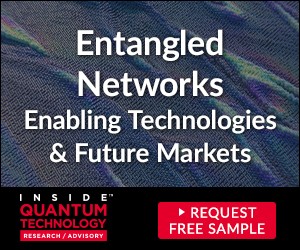Quantum News Briefs July 28: IBM bolsters quantum cryptography for z16 mainframe, Google partners with 4 Australian Universities & set up outpost that capture talent, IQT Cybersecurity speaker an author of Rand Corporation report assessing U.S. & Chinese industrial bases in quantum technology & MORE

Quantum News Briefs today opens with IBM bolstering quantum cryptography for z16 mainframe followed by Google recently announced partnership with 4 Australian Universities that will set up outpost that capture ‘down-under’ quantum talent. A research report whose authors included IQT Cybersecurity speaker Edward Parker of the Rand Corporation report that assesses the U.S. & Chinese industrial bases in quantum technology is described & linked for our readers & MORE.
****
IBM Bolsters Quantum Cryptography for z16 Mainframe
 IBM has added additional mainframe protection against future quantum-based security attacks. Michael Cooney, Senior Editor at Network explains. IQT News summarizes for our readers.
IBM has added additional mainframe protection against future quantum-based security attacks. Michael Cooney, Senior Editor at Network explains. IQT News summarizes for our readers.
When IBM rolled out the newest iteration of its mainframe – the z16—in April, one of its core design pillars was a promise to protect organizations from anticipated quantum-based security threats. Specifically, the z16 supports the Crypto Express8S adapter to deliver quantum-safe APIs that will let enterprises start developing quantum-safe cryptography along with classical cryptography and to modernize existing applications and build new applications, IBM stated.
IBM has now added the four U.S. National Institute of Standards and Technology (NIST) algorithms that were chosen to create a post-quantum cryptography (PQC) standard built upon encryption algorithms that can protect against future quantum processor-based attacks. Additional technology will be added to the standard in the future.
IBM was deeply involved in the building of those algorithms, as it developed technology for three of the four. The NIST algorithms are designed for two of the main tasks for which public-key cryptography is typically used: public key encapsulation, which is used for public-key encryption and key establishment; and digital signatures, which are used for identity authentication and non-repudiation, according to Anne Dames, Distinguished Engineer, Cryptographic Technology at IBM, who wrote a blog about the technology.
*****
Google’s Partnership with 4 Australian Universities to Develop Applications for Quantum Computers to be Based in the Australian Research Hub

Google announced it has partnered with researchers at the University of NSW, the University of Sydney, Macquarie University and the University of Technology Sydney (UTS) to find applications for the quantum computer it is building in the US. John Davidson of Financial Review covered this announcement and Quantum News Briefs summarizes for our readers.
The Australian scientists would be working to develop industrial applications for existing quantum computing algorithms, rather than trying to devise new algorithms, said Hartmut Neven, the founder and engineering vice-president of Google’s Quantum Artificial Intelligence Lab (QuAIL) in California. Google’s long-term goal, however, is to develop bigger, more sophisticated quantum algorithms that can be used in applications such as machine learning and artificial intelligence, making quantum computing useful to the company’s core business of selling ads, he said.
Google’s collaboration with the universities will be spearheaded out of the Australian Research Hub the advertising giant has just opened in Sydney. It has contracted Marika Kieferova, a lecturer in quantum algorithms at UTS, to run the collaboration.
“Australia is punching above its weight in terms of investments and successes in quantum computing,” Dr Neven said, noting that some of the experts at QuAIL had been trained in Australia.
“There’s a broad range of [quantum] activities going on in Australia, and it was just natural for us, given the scarcity of global talent in this space, to tap into Australian collaborations,” he said.
****
An Assessment of the U.S. and Chinese Industrial Bases in Quantum Technology

Edward Parker, a speaker at the upcoming IQT Quantum Cybersecurity in NYC is one of the authors of a 139-page research report from the Rand Corporation available for free in PDF format on the Rand Website.
The authors developed a set of metrics for assessing a nation’s overall quantum industrial base (QIB), broadly defined, applied them to the United States and to the People’s Republic of China, and concluded with recommendations for policymakers. The metrics are: 1 research; 2 government activity; 3 private industry; 4 technical. They began by discussing three broad strategic goals of the department for the domestic QIB: quantum technology leadership, quantum technology availability, and the financial stability of QIB firms.
Key findings:
–The United States’ overall scientific research output in quantum information science is broad, stable, and at or near the global forefront in every application domain.
–The U.S. government is the primary funder of open QIS research.
–U.S. quantum technology deployment is now driven by the private sector.
–The United States leads in demonstrated technical capability in quantum computing and sensing but not in quantum communications.
–Like the United States, China has high research output in every application domain of quantum technology.
Chinese reports of total government R&D funding for quantum technology are wildly conflicting.
–China leads in demonstrated technical capability in quantum communications.
–The eventual applications of quantum technology and their timelines remain highly uncertain.
Click here for information on Edward Parker’s two presentations at IQT Quantum Cybersecurity, NYC October 25-27.
****
An Alternative Superconducting Qubit Achieves High Performance for Quantum Computing

Researchers at Alibaba Quantum Laboratory, a unit of Alibaba Group’s DAMO research institute, have recently developed a quantum processor using fluxonium qubits, which have so far not been the preferred choice when developing quantum computers for industry teams. Their paper, published in Physical Review Letters, demonstrates the potential of fluxonium for developing highly performing superconducting circuits.
“This work is a critical step for us in advancing our quantum computing research,” Yaoyun Shi, Director of Alibaba’s Quantum Laboratory, told Phys.org. “When we started our research program, we decided to explore fluxonium as the building block for future quantum computers, deviating from the mainstream choise for future quantum computers of the transmon qubit. We believe that this relatively new type of superconducting qubit could go much further than transmon.”
In initial tests, the quantum platform designed by Chunqing and his colleagues was found to attain an average single-qubit gate fidelity of 99.97% and a two-qubit gate fidelity of up to 99.72%. These values are comparable to some of the best results achieved by quantum processors in previous studies.
“Our study introduces an alternative choice to the widely adapted transmon,” Chunqing said. “We hope that our work will inspire more interest in exploring fluxonium, so that its full potential can be unlocked to achieve a significantly higher performance in fidelity, which will in turn significantly reduce the overhead of realizing fault-tolerance quantum computing. What this means is that, for the same computational task, a higher-fidelity fluxonium quantum computer may need significantly fewer number of qubits.”
****
Graphic Processors Serving as Surrogate Quantum Computers
 Graphics processors are now serving as surrogate quantum computers until the real hardware arrives. The Jülich Supercomputing Centre is using GPUs and a software toolkit from Nvidia to emulate quantum computers and research algorithms for such systems. With quantum processors still under development, GPUs are the fastest circuits to play the role of fully operational quantum computers.
Graphics processors are now serving as surrogate quantum computers until the real hardware arrives. The Jülich Supercomputing Centre is using GPUs and a software toolkit from Nvidia to emulate quantum computers and research algorithms for such systems. With quantum processors still under development, GPUs are the fastest circuits to play the role of fully operational quantum computers.
The supercomputing center has bought in Nvidia’s QODA to help move that compute over to graphics processors, said Kristel Michielsen, who leads a research group on quantum information processing at the center.
Nvidia recently launched Quantum Optimized Device Architecture (QODA), which provides a software layer through which GPUs can emulate quantum computers and run algorithms. QODA is to quantum computing on GPUs what Nvidia’s CUDA is for AI and scientific applications on GPUs.
The road for Jülich Supercomputing Centre to practical quantum computing goes through conventional computing, including software emulators like QODA. Jülich researchers prepare an algorithm for the real device based on such simulators, which play an important role in preparation for deployment of applications on real quantum computers.
Jülich has declared it will house Europe’s first supercomputer that will break the exascale mark. The center already has D-Wave’s quantum annealer – the only such system in Europe – and a quantum simulator of the French startup Pasqal, which is focused on building a quantum computer based on neutral atoms. It also has Atos’ quantum learning machine, which can simulate up to about 40 qubits. The center is also looking to install or provide cloud-based access to other types of hardware, including an ion-trap and superconducting qubit system.
****

























